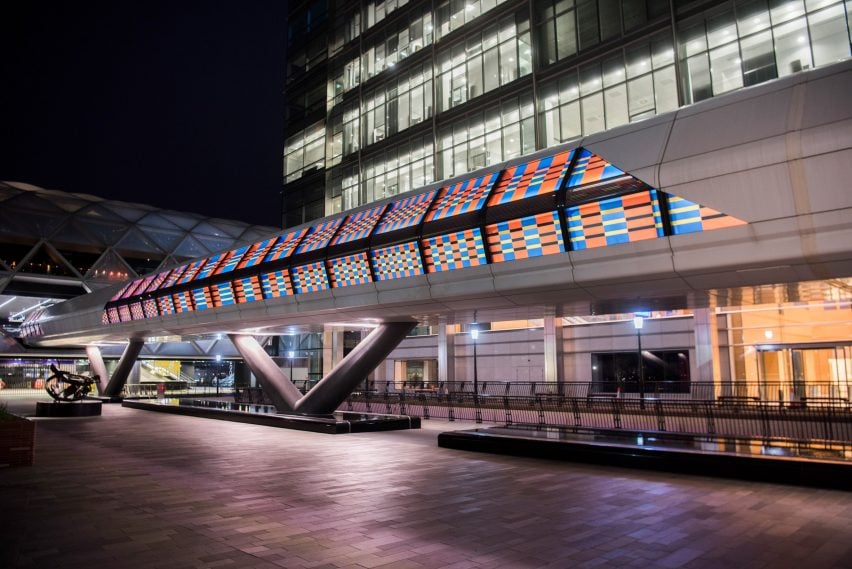
"I don't just want to create popular Instagram spots" says Camille Walala
Camille Walala has created two public artworks for the inaugural London Mural Festival as part of a new focus on community-oriented projects. The French designer tells Dezeen why she is now being more selective with her commissions.
As part of the London Mural Festival Walala created an artwork for the charitable arts and culture centre Rich Mix in Shoreditch. The work is an example of a renewed emphasis on the social impact of her work.

After rising to prominence in recent years, with her colourful, Memphis-meets-tribal patterns that are shared widely on social media, Walala now feels she is in the position to be more selective with who she works with.
"I had 10 years of struggle, where I was saying yes to everything because I didn't have much work to start with," Walala told Dezeen.

"But now I've done some really great projects and I'm trying to make very conscious decisions in terms of the responsibility and sustainability of my designs," she continued.
"There are companies that have wanted to work with me because they knew it would push their popularity [on social media] and I've been saying no to working with them because I don't just want to create popular Instagram spots."
Adding colour to buildings "has such a strong impact"
In recent months, the designer has tackled several projects in her adoptive home of east London, which engage with the local community and community organisations.
The work created for Rich Mix comes shortly after Walala's first crowdfunded project saw an entire high street block in Leyton repainted.
"Bringing colours and patterns onto buildings is not really hard but it has such a strong impact on people to have some kind of positive, joyful artwork in their community," the designer said. "It gives them something to be proud of and it's a way to show the community that we care about them."
"The uglier the building is, the happier I am to refresh it," she added.
Walala's piece largest at London Mural Festival
As part of the London Mural Festival, more than 40 large-scale walls will be painted across the capital by a roster of international street artists including Walala, calligraphy artist Seb Lester and illustrator Marija Tiurina.

Walala's Rich Mix mural, called Belleville, is the largest artwork being created as part of the festival and stretches across all 600 square metres of the cultural centre's three back walls.
"I find Rich Mix and this area of east London so interesting. It was one of the first places I spent time when I moved to London," said Walala. "It is so great that this independent arts centre and cinema is still standing strong, I think it is a real institution."

The charity's CEO Judith Kilvington heralded the work as an example of the "transformative power of culture and creativity", capable of outwardly reflecting "the dynamism and energy" of the activities that usually take place inside the Rich Mix building.
Unlike Walala's previous work, which squeezes a cacophony of patterns and graphics into the space provided by different architectural details, this piece makes use of its vast, uninterrupted canvas to play with more oversized shapes.

"I love working with the restrictions of a space," said Walala. "At Rich Mix there are a lot of windows that are not especially symmetrical, so I had to create a pattern that works for them."
"With the projects I did on [London's] Old Street and in New York, I worked with their symmetrical rows of windows. But this time around I created something that looks a bit more like a collage."
Walala's second contribution tackles Adams Plaza Bridge in the financial district of Canary Wharf. Like her recent murals in White City, it was created for a private property developer that has arguably contributed to the areas' rapid gentrification.
The project marks the first time the designer has taken on a bridge as her canvas, exaggerating the perspective of the futuristic, tunnel-like overpass by covering it in Op Art-style stripes and lines.

This includes not just the walls and ceiling but also the windows, which are clad in transparent strips of colour the let in light from the outside and, at night, make the bridge appear like a kaleidoscope illuminated from within.
"I'd love to collaborate with architects"
Rather than transplanting an existing design onto a structure, Walala's work is created as a direct response to a building and its particular anatomy – a fascination, which she picked up from her architect father.

"I get excited by details in architecture and colours and then that's the starting point for a composition," she said.
"I work on a virtual, 3D model of the building and almost give it another identity by bringing out some volume here or playing with the perspective and the pattern there. That's the challenge I set for myself."

Her transformation of a facade in Brooklyn, for example, plays up the building's flat, symmetrical structure by making it appear almost like a cartoon, while her renovation of a hotel in Mauritius saw structural columns accentuated via a horizontal pattern of black and white stripes.
Ultimately, the designer hopes to extend her work to even an even larger urban setting, in order to give citizens back a sense of ownership over their cities.

"I'd love to collaborate with architects and to keep working with public space on a different scale," she said. "I started with benches but I want to create more colourful places that bring people together, like a big plaza where people can interact and communicate."
Photos of Belleville are courtesy of the London Mural Festival and images of Adams Plaza Bridge are by Sean Pollock.